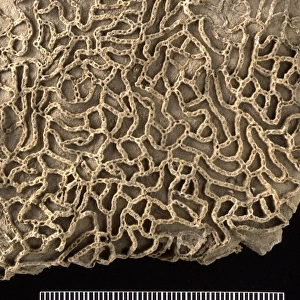Home > Historic > Colonial history
Halysites a coral
![]()

Wall Art and Photo Gifts from Mary Evans Picture Library
Halysites a coral
Halysites, a Silurian coral also known as a chain coral. Corals comprise a soft bodied animal called a polyp. Each polyp inhabits a calcareous skeleton called a corallum
Mary Evans Picture Library makes available wonderful images created for people to enjoy over the centuries
Media ID 8596771
© Mary Evans Picture Library 2015 - https://copyrighthub.org/s0/hub1/creation/maryevans/MaryEvansPictureID/10703611
Anthozoa Anthozoan Calcareous Calcium Carbonate Carbonate Carbonate Mineral Cnidaria Cnidarian Coelenterata Coelenterate Colony Coral Mineral Invertebrata Polyps
EDITORS COMMENTS
1. Title: "A Glimpse into the Past: The Fascinating World of Halysites, a Silurian Chain Coral" 2. Description: This image showcases a stunning example of Halysites, an ancient coral species belonging to the class Anthozoa, within the phylum Cnidaria and the class Coelenterata. Halysites is also known as a tabulate coral or chain coral, due to its distinctive tabular growth form and colonial structure. 3. Background: Halysites was a common coral during the Silurian period, around 443 to 416 million years ago. These ancient organisms were invertebrates, meaning they lacked a backbone, and were characterized by their soft bodies enclosed within a hard calcareous skeleton, or corallum. 4. Anatomy: Each Halysites polyp was shaped like a small cup with a mouth surrounded by tentacles. The polyps lived in close proximity to one another, forming a colony. The calcareous skeletons of these polyps grew in a tabular, or flat, arrangement, creating the characteristic chain-like appearance. 5. Composition: The mineral composition of Halysites skeletons is primarily calcium carbonate, a carbonate mineral. This mineral provided the necessary structural support for the coral colonies to thrive in their ancient marine environments. 6. Significance: The discovery of Halysites and other ancient corals has provided valuable insights into the early development of complex marine ecosystems. These fascinating organisms played a crucial role in the formation of carbonate sediments, which continue to shape our planet's geology today. 7. Conclusion: This evocative image of Halysites offers a glimpse into the rich history of life on Earth. As we marvel at the intricate beauty of this ancient coral, we are reminded of the incredible adaptability and resilience of nature.
MADE IN AUSTRALIA
Safe Shipping with 30 Day Money Back Guarantee
FREE PERSONALISATION*
We are proud to offer a range of customisation features including Personalised Captions, Color Filters and Picture Zoom Tools
SECURE PAYMENTS
We happily accept a wide range of payment options so you can pay for the things you need in the way that is most convenient for you
* Options may vary by product and licensing agreement. Zoomed Pictures can be adjusted in the Cart.




